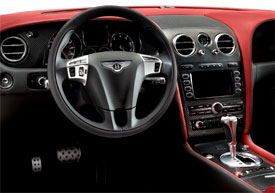2010 Bentley Continental Supersports
Big, graceful, race-bred Bentleys are certainly nothing new. Since the early ‘20s, they’ve earned the company six Le Mans wins and the prestige that goes along with them. Indeed, super-luxurious Bentley four-doors have basked in the limelight for decades now. But, for 2010, Bentley has built a very special coupe, and revived the Supersports name to go with it. So, we jumped at the chance to see just how super it really is.
The 2010 Bentley Continental Supersports’ silhouette is little changed from its less potent Continental stablemates. They all share a 108.1-inch wheelbase and a 189.1-inch overall length, but racy styling cues help this fastest Bentley ever stand out.
A central ‘letterbox’ intake and two vertical apertures in the front fascia feed 10% more air through the Supersports’ radiator and intercoolers. All of the mesh on the front end- from the intakes to the familiar Continental grille to the twin heat extractors in the hood- is finished in the same “smoked steel” as the headlight bezels, 20-inch ten-spoke alloy wheels, and rocker panel trim.
Classic big-coupe good looks have worked just fine for the Continental so far, and the Supersports is no exception. Well-drawn body lines sweep over wider rear fender flares, which accommodate a two-inch wider rear track.
 From behind, the Supersports is distinguished by smoked taillights and larger-diameter exhaust outlets set in a narrow black surround. The overall effect is a very menacing Bentley.
From behind, the Supersports is distinguished by smoked taillights and larger-diameter exhaust outlets set in a narrow black surround. The overall effect is a very menacing Bentley.
For motivation, the Supersports relies on the same 6.0-liter, twin-turbo W12 that has been under the Continental’s hood since its debut in 2004. But this time around, there’s 621 horsepower and 590 pound-feet of torque on tap.
That’s a bump of 21 horses and 37 pound-feet over the Continental GT Speed, and a leap of 69 horsepower and 111 pound-feet over the Continental GT. The heavily-revised ZF six-speed ‘Quickshift’ automatic with wheel-mounted paddle shifters is the only available transmission, and it cuts fuel and ignition between gear changes for lightning-quick shifts. In ‘Sport’ mode, they’re almost telepathic.
The extra power hauls a car featuring lightweight wheels, carbon-ceramic brakes, revised aluminum suspension components, and no rear seats. All told, the Supersports weighs in at 4,939 pounds, 243 pounds lighter than the GT Speed.
At the track, it was a velvet sledgehammer. Power builds up fast and smooth, and its baritone around-town burble gave way to a primal roar at wide-open throttle. Our Supersports blazed from a standstill to 60 in 3.9 seconds-that’s eight tenths quicker than the GT-and through the quarter mile in 12.3 seconds at 115 miles per hour, figures that put it in the same league as much more spartan supercars.
Through the slalom, the all-wheel drive Supersports’ revised dampers and anti-roll bars, coupled with its new 40/60 rear-biased torque split, made for quick, neutral responses in corners.
Steering has been retuned too, and we found it to be quick and direct but with little feedback. Being ham-fisted results in understeer, while being overzealous with the gas tipped the Supersports over into power oversteer. For being as big and heavy as it is, however, the Supersports is very agile, with minimal body roll even in high-speed maneuvers.
Those big carbon-ceramic brakes snapped it all to a dead halt from 60 in a very impressive average of 109 feet. The pedal is soft, but travel is short, and stops were stable and fade-free.
For all the dynamic gains on the track, the Supersports loses a little refinement on the road. The ride is somewhat stiffer, but nothing we couldn’t put up with. Bentley-exclusive manually adjustable Sparco sports seats were noticeably thin on padding, but generously trimmed in leather and diamond-pattern Alcantara and still very comfortable.
 The dash largely carries over from the regular Continental, with a substantial center stack and two “wings”- in the Supersports’ case, trimmed in leather and faced in carbon fiber.
The dash largely carries over from the regular Continental, with a substantial center stack and two “wings”- in the Supersports’ case, trimmed in leather and faced in carbon fiber.
The biggest difference from the driver’s seat is the leather three-spoke steering wheel. And, as usual, Bentley has the details perfect, from the Breitling clock and organ-stop vent controls to the drilled alloy sports pedals.
Now, there’s only room for two, but they’ll enjoy standard satellite navigation, front and side curtain airbags, and 10-speaker sound.
As you might surmise, Government Fuel Economy ratings are low: 12 city, 19 highway. Our test loop returned 13.9 miles per gallon on premium gas. But Bentley has become eco-minded. By summer, the Supersports will be the first Bentley that runs on E85, and by 2012, the entire lineup will be FlexFuel capable. Available now in very limited numbers, the Supersports starts at $272,195 including a $2,600 gas guzzler tax.
The 2010 Bentley Continental Supersports delivers such astonishing performance that the slight ride penalty is easily overlooked. It’s more like its famous racer namesakes than any road-going Bentley ever built, and is indeed a fitting tribute to those proud Winged ‘B’ warriors.
Specifications
- Engine: 6.0-Liter, Twin-turbo W12
- Horsepower: 621
- Torque: 590 Lb Feet
- 0-60 MPH: 3.9 Seconds
- 1/4 Mile: 12.3 Seconds @ 115 MPH
- 60-0 MPH: 109 Feet
- EPA: 12 MPG City/ 19 MPG Highway
- Mixed Loop: 13.9 MPG
2024 Polestar 2
More Range And More Power For The Polestar 2
Volvo is well on their way to making the transition to an all-electric brand, but their sister-brand Polestar is already there. Now, we’ve spent lots of time in their all-wheel drive, five-door Polestar 2, having tested it in 2021, and a year later when a two-wheel drive version arrived. But, EV updates are coming quickly. So, let us be your guide for all that’s new with the Polestar 2.
While we are driving more EVs than ever, we’ve also been spending a lot of time recently circling back to ones we’ve previously tested. As in this new era of electrified vehicles, significant updates are arriving quickly, with R&D investments increasing and retrofitting them easier than ever. This is often done through software updates that can even be accomplished over the air. For 2024, the Polestar 2 has indeed gotten some software updates, but some physical ones as well.
Clearly aimed directly at Tesla’s Model 3 when it arrived; the Polestar 2’s build quality was vastly better, but range definitely came up short. So, addressing that was priority No. 1; and for ’24 the Polestar can travel up to 20% farther than before while consuming 9% less energy, and when it comes time to charge it back up, it can do that 34% faster too.
Range in the Single Motor version increases from a max of 270 to 320 miles thanks to a larger 82-kWh battery pack, and that solitary motor now powers the rear wheels, not the front wheels. It’s also bigger, coming in at 220 kW compared to the previous 170 kW front-wheel drive version, going from 231 to 299 horsepower.
Dual Motors keep the same 78-kWh battery, but still sees a boost from 260 to 276 miles and takes advantage of the larger rear motor for a new combined 310-kW output with 421 horsepower. Our test car has the added Performance Pack, which uses an additional 35 kW to deliver 455 horsepower and 546 lb-ft of torque, though max range drops to just 247 miles.
The new battery in rear-drive 2s will also charge faster, now accepting up to 205 kW for an 80% charge in 20 minutes; max for dual-motors stays at 155 kW, which puts an 80% charge at 34 minutes. Using 32 kWh of electricity per 100 miles, the Dual Motor earns a good efficiency rating.
The [Polestar] 2 has always been one of the most enjoyable EVs to drive, even more so now with that additional power coming from the rear motor.
Unfortunately, extremely cold temperatures kept us from seeing that increased range, as we were only on pace for about 194 miles in our test.
The 2 has always been one of the most enjoyable EVs to drive, even more so now with that additional power coming from the rear motor. And especially when equipped with the Performance Pack as it not only includes more power, but adds 20-inch forged wheels, upgraded brakes, and adjustable Ohlins Dual Flow Valve performance dampers. It greatly improves handling prowess without affecting ride quality, and is easily worth the $5,500 charge if you at all enjoy driving.
Even on a 20-degree track day there was plenty of grip through our handling course. No understeer or oversteer, and lots of feedback through the wheel. There was a nice, strong launch off the line that properly planted us firmly in the seat, and rocketed us to 60 in 4.5 seconds. Power delivery stayed pretty intense up until about 80 mph when there was a definite tapering off. Still, it was a 13.4-second quarter-mile at 102 mph; smooth, quiet, and stable the whole way.
When this car debuted, its Google-based infotainment setup was a novelty, but since then, more and more manufacturers are just “Googling it” so it doesn’t seem out of place at all. The wireless phone charger is easy to access, and there’s a great Harmon/Kardon sound system and panoramic sunroof to enhance the in-cabin experience. Exteriors have also been enhanced with a smooth grille insert and new wheel choices.
Hatchback practicality means 14.3 cu-ft of easy to access cargo space with split-folding seatbacks for longer items and expanding the space to 38.7 cu-ft. Plus, there’s even a sizeable storage bin up front under the hood.
Single Motor Polestar 2 pricing now starts at $51,300, with Dual Motors starting at $56,700; topping out at $64,400.
For a car manufacturer that hasn’t even been around for a decade yet, Polestar has kept itself busy, totally transforming their latest model in just a few years, making the 2024 Polestar 2 even more appealing. They are certainly off to a good start, and with a host of Polestars just over the horizon, including some all-important utility vehicles, this star will be shining even brighter.
Specifications
As Tested
- Motor Setup: Dual Motor
- Horsepower: 455
- 0-60 mph: 4.5 seconds
- EPA Range: 247 miles
- Efficiency : 32 kWh / 100 miles
- Battery Size: 78-kWh
- Torque: 546 lb-ft
- 1/4 Mile: 13.4 seconds at 102 mph
- MW Test Loop: ~ 194 miles
- Peak Charging Rate: 155 kW











































